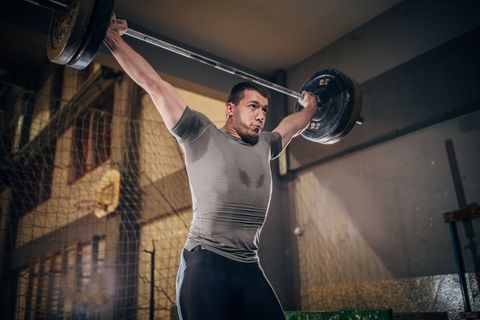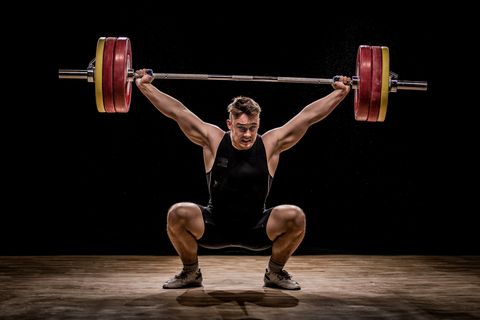The power snatch is an awesome weightlifting accessory exercise to help build power and fluidity for the more traditional full snatch. In the context of a training program, the power snatch can be a useful accessory for snatch technique work, improving power output, and building upper body pulling mechanics in the snatch.
To execute great power snatches, it’s important to pay attention to the subtle details of this exercise as they’ll help to maximize the benefits for technique work and physical adaptations. Personally, I like to use power snatches in my programming when I want to build snatch pulling power. Plus, the power snatch variation is not as technically driven as the traditional snatch, which requires a deeper squat under the loaded barbell, so the variation is a tad easier to program more regularly.
Let’s break down how to perform muscle snatches, muscle snatch benefits for your training plan, and common muscle snatch mistakes so you can determine whether the exercise is right for you.
How to Do the Power Snatch
Remember, power snatches are only power snatches if the weight is caught when you’re above a parallel squat position. If you’re dropping any lower, then you’re not performing power snatches and you may want to drop the load slightly to improve power snatch mechanics.

When performing and programming power snatches, you’ll generally want to use lighter weights than you would doing full snatches. Since we’re catching the weight higher, we have less time to get under the barbell, so lighter loads are usually prescribed for this exercise. The percentage of weight used will be contextual towards your training goals, needs, and skill level.
Power Snatch Benefits

There are a few key benefits that come along with the power snatch and these benefits will be contextual based on your needs and application of this exercise.
1. Great for Technique Work
If you’re newer to snatching and you have trouble being patient with your final pull and punch, then the power snatch can be a great tool to help teach you patience with your snatch.
Since we’re actively trying to finish in a taller/higher catching position in regard to the hips, we’re going to be forced to be hyper-cognizant of what’s going on during the final 30 percent of our pull in relation to our speed under the barbell, a.k.a. improving the authority of our turnover positioning.
2. Good for Warmups
On top of technique work, power snatches can also be a good upper body warmup drill to prep for full snatches. Since you’ll be using a lighter load, power snatches can be useful for prepping the musculature needed for catching and stabilizing snatches.
3. Decent Option for Non-Weightlifting Athletes
For the small subsection of lifters that want to perform snatch variations without doing full snatches, the power snatch can be a good option. This is often why we’ll see the exercise programmed into functional fitness workouts and collegiate training settings.
Power snatches are loaded lighter than traditional snatches, don’t require nearly as much technical focus throughout the full kinetic chain, and are still challenging to achieve some upper body pulling benefits.
The Most Common Power Snatch Mistakes

There are two common power snatch mistakes that beginners and non weightlifting-focused athletes tend to make with the muscle snatch.
1. Going Too Heavy—Power or Nah?
The first and common mistake is going too heavy. If you’re having to bend and catch the weight in a full snatch position (below a parallel squat position), then what you’re really doing is a snatch. That being said, this is why it’s important to let your skill and current strength dictate the load of this exercise to ensure you’re catching the weight high enough.
If you’re not performing power snatches with a clear intent of catching them in a taller position, then you won’t be getting the full benefit that they can provide in regard to power production.
2. Not Being Patient
On top of going too heavy, another mistake you’ll see with the power snatch is rushing the turnover of the pull. This will present itself as a lifter breaking at the arms far too soon, then being in a position where their mechanics are disadvantaged to finish the turnover with a taller catching position.
It’s important to remember with power snatches to make the primary intent being strong fast with the second pull and turnover phase, then actively focusing on catching the weight slightly higher than traditional snatches.
Performance Takeaways
When performing power snatches, remember to let your abilities dictate the load on the bar. If you’re having to bend to catch weight, then you’re not getting the full benefit of this exercise.
Power snatches are awesome for working second pull and turnover technique in the snatch and can also be a great snatch variation for non-weightlifting athletes that want to practice this movement, but not dive into full snatches.
Source: Read Full Article
